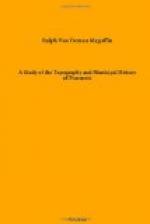The lower temple with its precinct, along the north side of which extends a wall and the ruins of a so-called cryptoporticus which connected two caves hollowed out in the rock, is not so very large a sanctuary, but it occupies a very good position above and behind the ancient forum and basilica on a terrace cut back into the solid rock of the mountain. The temple precinct is a courtyard which extends along the terrace and occupies its whole width from the older cave on the west to the newer one at the east. In front of the latter cave is built the temple itself, which faces west along the terrace, but extends its southern facade to the edge of the ancient forum which it overlooks. This temple is older than the time of Sulla, and occupies the site of an earlier temple.
Two terraces higher, on the Cortina terrace, stretch out the ruins of a huge construction in opus incertum. This building had at least two stories of colonnade facing the south, and at the north side of the terrace a series of arches above which in the center rose a round temple which was approached by a semicircular flight of steps.[101] This building, belonging to the time of Sulla, presented a very imposing appearance from the forum below the town. It has no connection with the lower temple unless perhaps by underground passages.
Although this new temple and complex of buildings was much larger and costlier than the temple below, it was so little able to compete with the fame of the ancient shrine, that until mediaeval times there is not a mention of it anywhere by name or by suggestion, unless perhaps in one inscription mentioned below. The splendid publication of Delbrueck[102] with maps and plans and bibliography of the lower temple and the work which has been done on it, makes unnecessary any remarks except on some few points which have escaped him.
The tradition was that a certain Numerius Suffustius of Praeneste was warned in dreams to cut into the rocks at a certain place, and this he did before his mocking fellow citizens, when to the bewilderment of them all pieces of wood inscribed with letters of the earliest style leaped from the rock. The place where this phenomenon occurred was thus proved divine, the cult of Fortuna Primigenia was established beyond peradventure, and her oracular replies to those who sought her shrine were transmitted by means of these lettered blocks.[103] This story accounts for a cave in which the lots (sortes) were to be consulted.
But there are two caves. The reason why there are two has never been shown, nor does Delbrueck have proof enough to settle which is the older cave.[104]




